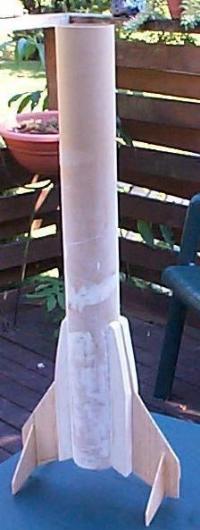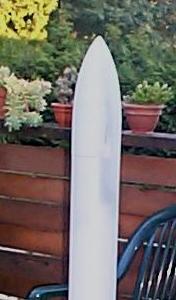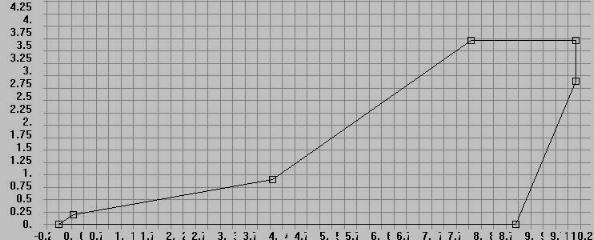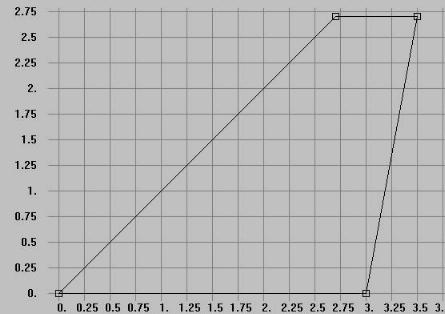| Manufacturer: | Scratch |

 My rocket was inspired by an Estes Sliver. I planned to upscale it using a 3" mailing tube for the body. 1/8" balsa fins and a custom turned balsa nose cone and install a 38 mm motor mount to take advantage of the 38 mm G's available during the 29 mm engine drought. The fins will be overlayed with 3/4 oz fiberglass and epoxy resin.
My rocket was inspired by an Estes Sliver. I planned to upscale it using a 3" mailing tube for the body. 1/8" balsa fins and a custom turned balsa nose cone and install a 38 mm motor mount to take advantage of the 38 mm G's available during the 29 mm engine drought. The fins will be overlayed with 3/4 oz fiberglass and epoxy resin.
The paint was designed to make the rocket highly visible during flight and recovery.
For decals , I planned to make them on my PC using a clear Avery 8 1/2" x 11" mailing label and I will water proof them with a mat spray used for inkjet photos. I have done this before and it worked really well. Unfortunately, my printer had to go in for repairs and the decals weren't ready at flight time.
To ensure a stable flight, I made slight increase in fin area and added 3" to the body length which will help with the static margin due to the weight of the 38 mm motor mount and a 38 mm motor. (safety first). I estimate an altitude of 1800' on a CTI G60.
This rocket can't be simmed by RocSim so I was forced to do it the old fashioned way, long hand calculations and a swing test. The rocket passed the swing test with flying colors and so I was set to launch.
The first flight was powered with an Aerotech F40 using a 6 second delay. I estimated the altitude at about 1800'. The chute opened on schedule, slightly after apogee, unfortunately it landed on a rock and a fin was in need of some glue.
Rocket parts
 Nose cone - Custom, Material: Balsa - 1 required
Nose cone - Custom, Material: Balsa - 1 required
- Nose shape: Solid Ogive, Len: 6.000 In., Dia: 3.000 In.
- Body insert: OD: 2.650 In., Len: 1.250 In.
- CG: 5.739 In. , Mass: 3.266 oz.
Body tube - Custom, Material: Cardboard - 1 required
- OD: 3.0 In. , ID: 2.7 In. , Len: 25In.
- CG: 12.5 In. , Mass: 13.368 oz.
Custom Fin set - Custom, Material: 1/8" Balsa - 2 required
- CG: 7.045 In. , Mass: 0.731 oz.

Custom winglets set - Custom, Material: 1/8" Balsa - 4 required
- CG: 2.146 In. , Mass: 0.286 oz

 Motor mount tube Public Missiles Ltd. - PT-1.5 - Airframe tube, Material: Kraft phenolic - 1 required
Motor mount tube Public Missiles Ltd. - PT-1.5 - Airframe tube, Material: Kraft phenolic - 1 required
- OD: 1.649 In. , ID: 1.525 In. , Len: 14.625 In.
- Location: 0.000 In. From the base of Body tube
- CG: 7.313 In. , Mass: 2.505 oz.
Engine Retainer - 1 required
- CG: 0.000 In. , Mass: 1 oz.
Centering ring - Custom, Material: 1/4 Aircraft Plywood - 2 required
- Centering ring OD: 2.700 In., ID: 1.649 In., Len: 0.250 In.
- Location: 11.125 In. & 23.750 In. from the front of Body tube
- CG: 0.125 In. , Mass: 0.179 oz.
Parachute - 24 in. nylon, Material: 1.3 oz. Ripstop Nylon (SkyAngle)
- 1 parachute, Shape: 8 sided
- Dia: 24 In., Spill hole: 6 In.
- CG: 0.000 In. , Mass: 1.60 oz.
Shock Cord - 4' long :
- CG: 0.000 In. , Mass: 2 oz.
Sponsored Ads
 |
 |











